Research - (2021) Volume 9, Issue 2
Knowledge, Awareness, Prevalence and Risk Factors of Self-Medication among Young Adult Population
Kethiswar Raj Rajendran and Karthik Ganesh Mohanraj*
*Correspondence: Karthik Ganesh Mohanraj, Department of Anatomy, Saveetha Dental College and Hospitals, Saveetha Institute of Medical And Technical Sciences, Saveetha University Tamilnadu, India, Email:
Abstract
Factors influencing frequency of self-medication in the previous studies are age, educational level, family attitudes, advertising of drug manufacturers, legislation regulating dispensing and sale of drugs, previous experiences with the symptoms or disease, significance attributed to the disease, home-kept prescription drugs and economic situation of respondents. Depression and anxiety may also be connected with self-medication. The aim of this research was to investigate prevalence and risk factors for self-medication among the population of medical students. A descriptive survey has been done among young adults in Chennai for 100 students ranging from first year to internship. The average cranial index for male is 71.32 and for female is 72.46, the average nasal index for male is 52.19 and for female is 51.57, the average Gnathic index for male is 93.61 and for female is 93.01. It is understood that both fever relieving medication and pain killers were up the main symptoms leading to self-medication. It is also understood that doctors were the most influential under source of information by 42% and advertisements, books and friends had the same value of (8%) and it is understood that young adults preferred idiopathic treatment compared, homeopathic treatment by a value of 54%.
Keywords
Risk factors, Self-medication, Young adults, Aged population, Depression, Anxiety
Introduction
According to the WHO's definition, selfmedication is the use of drugs to treat selfdiagnosed disorders or symptoms, or the intermittent or continued use of a prescribed drug for chronic or recurrent diseases or symptoms [1]. Factors influencing frequency of self-medication in the previous studies are age, educational level, family attitudes, advertising of drug manufacturers, legislation regulating dispensing and sale of drugs, previous experiences with the symptoms or disease, significance attributed to the disease, home-kept prescription drugs and economic situation of respondents. Depression and anxiety may also be connected with self-medication [2].
Self-medication among university students has been surveyed in different parts of the world. In the survey conducted among final year medical students in Slovenia, 94.1% students stated that they self-medicated. In the research among students of several different universities outside Europe, prevalence ranged from 38.5% in Ethiopia to 98.0% in Palestine [3]. A meta-analysis by Montgomery et al. which included 27 published studies from different countries showed that prevalence of self-medication among medical students and healthcare professionals was ranging from 12 to 99%. However, no larger study has been published which explores connection between depression, living conditions and demographic characteristics to self-medication [4] There are also no studies exploring self-medication among students, or the general population in Serbia. The only existing study was conducted among a population older than 65 years, in which 75% participants reported self-medication in the last month [5].
Survey of self-medication among the student population is important because this population represents a segment of highly-educated members of the society that have better access to healthcare-related information. Of particular significance is research of self-medication among the population of medical students, because they are the future generation that will have the right to prescribe drugs and to work on healthcare education. Additionally, their attitudes towards pharmacotherapy could affect the way they will prescribe medication in the future, as it was previously shown for prescribing antiinflammatory drugs [6].
Previous research showed that medical students and healthcare professionals are facing difficulties when seeking health care for themselves partially because of the competitive environment they are exposed to, where commitment and regularity in studying or work, and thus good health, are required [7]. The purpose of this paper is to investigate prevalence and risk factors for self-medication among the population of medical university students.
Previously our team had conducted several survey studies [8-10], anthropometric studies [11,12], in vivo animal experimental studies [12,13], genetics and bioinformatics studies [14]. Now we are focussing our research on epidemiological and related survey studies.
The aim of the present study was to analyse the knowledge, awareness, prevalence and risk factors of self-medication among the young adult population.
Materials and Methods
A descriptive survey has been done among young adults in Chennai for 100 students ranging from first year to internship. These students were given a specially designed questionnaire that had 10 questions related to the risk factors on selfmedication among young adults. The awareness of the depth of knowledge of each student was assessed using the survey questions. If the students were aware of the risk factors on selfmedication to know the percentage of students who are aware of it. Other questions such as the source of information about drugs used in selfmedication, to have a better understanding on how the message is delivered to the students as well as which medicinal systems they preferred and a range of types of medicinal systems were given to choose. What are the symptoms leading to self-medication to understand the reason behind self-medication? Questions based on the individual taking this survey was also asked to calculate a proper percentage between the age gaps, questions such as if they were male or female, of their marital status and if they have a partner. Questions based on the year of the study of students were also asked.
Results and Discussion
From the survey we can observe that, an equal percentage of 31% for both interns and second years had the highest number of students that took the survey, and a majority of the students that took this surgery are single with 85% of value and most of them live alone with a value of 46% compared to friends (31%) and family (23%), and it is understood that both fever relieving medication and painkillers were up the main symptoms leading to self-medication. It is also understood that doctors were the most influential under source of information by 42% and advertisements, books and friends had the same value of (8%) and it is understood that young adults preferred idiopathic treatment compared, homeopathic treatment by a value of 54% (Figures 1 to 7).
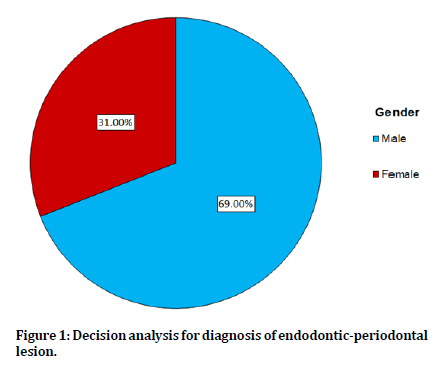
Figure 1. Decision analysis for diagnosis of endodontic-periodontal lesion.
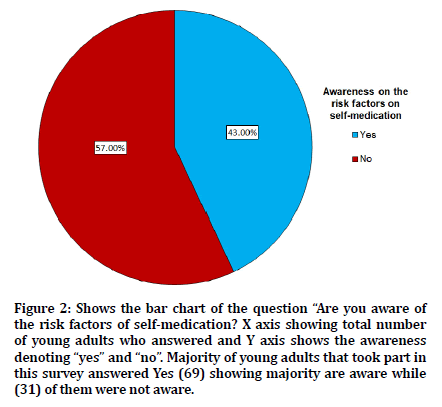
Figure 2. Shows the bar chart of the question “Are you aware of the risk factors of self-medication? X axis showing total number of young adults who answered and Y axis shows the awareness denoting “yes” and “no”. Majority of young adults that took part in this survey answered Yes (69) showing majority are aware while (31) of them were not aware.
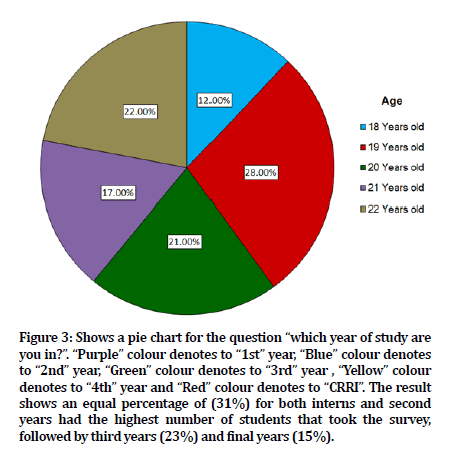
Figure 3. Shows a pie chart for the question “which year of study are you in?”. “Purple” colour denotes to “1st” year, “Blue” colour denotes to “2nd” year, “Green” colour denotes to “3rd” year , “Yellow” colour denotes to “4th” year and “Red” colour denotes to “CRRI”. The result shows an equal percentage of (31%) for both interns and second years had the highest number of students that took the survey, followed by third years (23%) and final years (15%).
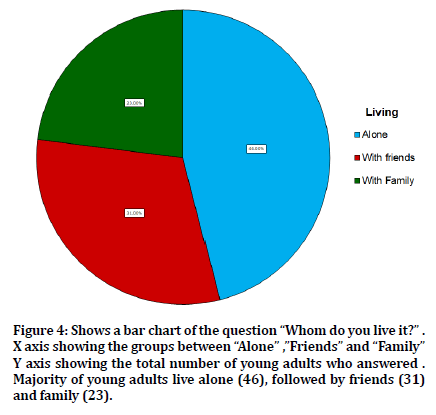
Figure 4. Shows a bar chart of the question “Whom do you live it?” . X axis showing the groups between “Alone” ,”Friends” and “Family” Y axis showing the total number of young adults who answered . Majority of young adults live alone (46), followed by friends (31) and family (23).
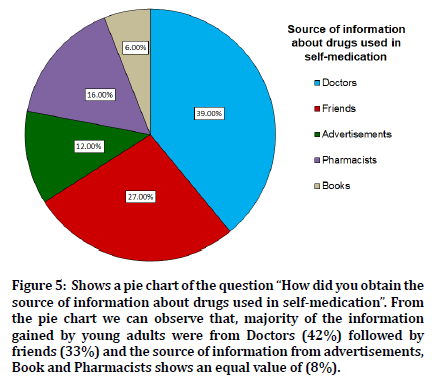
Figure 5. Shows a pie chart of the question “How did you obtain the source of information about drugs used in self-medication”. From the pie chart we can observe that, majority of the information gained by young adults were from Doctors (42%) followed by friends (33%) and the source of information from advertisements, Book and Pharmacists shows an equal value of (8%).
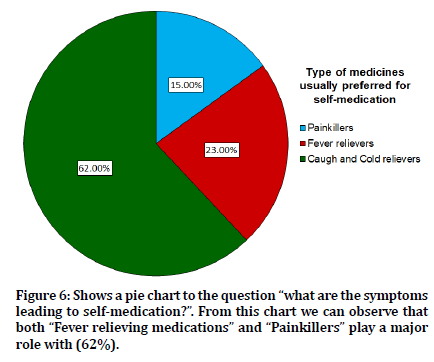
Figure 6. Shows a pie chart to the question “what are the symptoms leading to self-medication?”. From this chart we can observe that both “Fever relieving medications” and “Painkillers” play a major role with (62%).
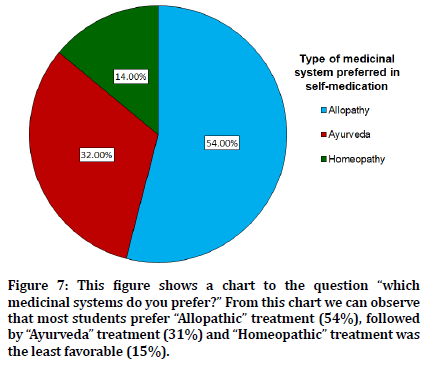
Figure 7. This figure shows a chart to the question “which medicinal systems do you prefer?” From this chart we can observe that most students prefer “Allopathic” treatment (54%), followed by “Ayurveda” treatment (31%) and “Homeopathic” treatment was the least favorable (15%).
Self-medication is a human behavior in which an individual uses a substance or any exogenous influence to self-administer treatment for physical or psychological ailments. The most widely self-medicated substances are over-thecounter drugs used to treat common health issues at home, as well as dietary supplements [15]. These do not require a doctor's prescription to obtain and, in some countries, are available in supermarkets and convenience stores. The field of psychology surrounding the use psychoactive drugs is often specifically in relation to the use of recreational drugs, alcohol, comfort food, and other forms of behavior to alleviate symptoms of mental distress, stress and anxiety, including mental illnesses and/or psychological trauma, is particularly unique and can serve as a serious detriment to physical and mental health if motivated by addictive mechanisms. In postsecondary (university/college) students, the use of self-medicating study-drugs such as Adderall, Ritalin, and Concerta has been widely reported and discussed in literature [16].
Products are marketed by manufacturers as useful for self-medication, sometimes on the basis of questionable evidence. Claims that nicotine has medicinal value have been used to market cigarettes as self-administered medicines. These claims have been criticized as inaccurate by independent researchers. Unverified and unregulated third-party health claims are used to market dietary supplements [17]. Selfmedication is often seen as gaining personal independence from established medicine and it can be seen as a human right, implicit in, or closely related to the right to refuse professional medical treatment. Self-medication can cause unintentional self-harm. Self-medicating excessively for prolonged periods of time with benzodiazepines or alcohol often makes the symptoms of anxiety or depression worse. This is believed to occur as a result of the changes in brain chemistry from long-term use. Of those who seek help from mental health services for conditions including anxiety disorders such as panic disorder or social phobia, approximately half have alcohol or benzodiazepine dependence issues [16].
Sometimes anxiety precedes alcohol or benzodiazepine dependence but the alcohol or benzodiazepine dependence acts to keep the anxiety disorders going, often progressively making them worse. However, some people addicted to alcohol or benzodiazepines, when it is explained to them that they have a choice between ongoing poor mental health or quitting and recovering from their symptoms, decide on quitting alcohol or benzodiazepines or both [18]. It has been noted that every individual has an individual sensitivity level to alcohol or sedative hypnotic drugs, and what one person can tolerate without ill health, may cause another to suffer very ill health, and even moderate drinking can cause rebound anxiety syndrome and sleep disorders. A person suffering the toxic effects of alcohol will not benefit from other therapies or medications, as these do not address the root cause of the symptoms [19,20].
Conclusion
From the survey study it is understood that both fever relieving medication and pain killers were up the main symptoms leading to selfmedication. It is also observed that doctors were the most influential under source of information and advertisements, books and friends had the same value and it is known that young adults preferred idiopathic treatment compared homeopathic treatment by many folds.
Acknowledgement
Nil
Conflicts of Interest
The authors declare that there are no conflicts of interest in the present study.
References
- Joung J. WHO informal consultation on regulatory evaluation of therapeutic biological medicinal products held at WHO Headquarters, Biologicals 2008; 2007:269–276.
- Gazibara T. Pharmacotherapy and over-the-counter drug use among elderly in Belgrade, Serbia’. Geriatric Nursing 2013; 34:486–490.
- Sawalha AF. A descriptive study of self-medication practices among Palestinian medical and nonmedical university students. Res Social Administrative Pharm 2008; 4:164–172.
- Abay SM, Amelo W. Assessment of self-medication practices among medical, pharmacy, health science students in gondar university, Ethiopia. J Young Pharm 2010; 2:306–310.
- Noaman AA. Self-medication practices among a sample of university students attending college of science in Diyala Province. J Adv Res Med Sci Techno 2020; 6:13–18.
- Hofmeister EH. Over-the-counter stimulant, depressant, and nootropic use by veterinary students. J Vetern Med Edu 2010; 37:403–416.
- Henley E, Wenzel-Wamhoff J. Teaching medical students about over-the-counter medications. Med Edu 2000; 34:580–582.
- Samuel AR, Thenmozhi MS. Study of impaired vision due to Amblyopia. Res J Pharm Tech Pub 2015; 8:912–914.
- Kannan R, Thenmozhi MS. Morphometric study of styloid process and its clinical importance on eagle’s syndrome. Res J Pharm Tech 2016; 1137.
- Krishna RN, Nivesh Krishna R, Yuvaraj Babu K, et al. Estimation of stature from physiognomic facial length and morphological facial length. Res J Pharmacy and Techno 2017.
- Thejeswar EP, Thenmozhi MS. Educational research-iPad system vs textbook system. Res J Pharm Techno 2015; 8:1158.
- Seppan P. Therapeutic potential of Mucuna pruriens (Linn.) on ageing induced damage in dorsal nerve of the penis and its implication on erectile function: An experimental study using albino rats. T Aging Male 2018; 1–14.
- Johnson J. Computational identification of MiRNA-7110 from pulmonary arterial hypertension (PAH) ESTs: A new microRNA that links diabetes and PAH. Hypertension Res 2020; 36:923.
- Sekar D. Methylation-dependent circulating microRNA 510 in preeclampsia patients. Hypertension Res 2009; 42:1647–1648.
- Brown BS, Chaitkin L. Use of stimulant/depressant drugs by drug abuse clients in selected metropolitan areas. Inter J Addictions 1981; 16:1473–1490.
- Klemenc-Ketis Z, Kersnik J. Sources and predictors of home-kept prescription drugs. Int J Clini Pharma Therapeutics 2010; 48:705–707.
- White V. Australian secondary students’ use of over-the-counter and illicit substances in 1999. Psyc Extra Dataset 2009.
- Kersnik J. Family doctors views of pharmaceutical sales representatives assessment scale. Psyc Tests Dataset 2015.
- Sriram N, Yuvaraj S. Effects of mobile phone radiation on brain: A questionnaire based study. Res J Pharm Technol 2015; 8:867–870.
- Klemenc-Ketis Z, Hladnik Z, Kersnik J, et al. Self-medication among healthcare and non-healthcare students at university of Ljubljana, Slovenia. Med Principles Practice 2010; 19:395–401.
Author Info
Kethiswar Raj Rajendran and Karthik Ganesh Mohanraj*
Department of Anatomy, Saveetha Dental College and Hospitals, Saveetha Institute of Medical And Technical Sciences, Saveetha University Tamilnadu, Chennai, IndiaCitation: Kethiswar Raj Rajendran, Karthik Ganesh Mohanraj, Knowledge, Awareness, Prevalence and Risk Factors of Self-medication among Young Adult Population, J Res Med Dent Sci, 2021, 9 (2): 295-299.
Received: 23-Sep-2020 Accepted: 17-Feb-2021
